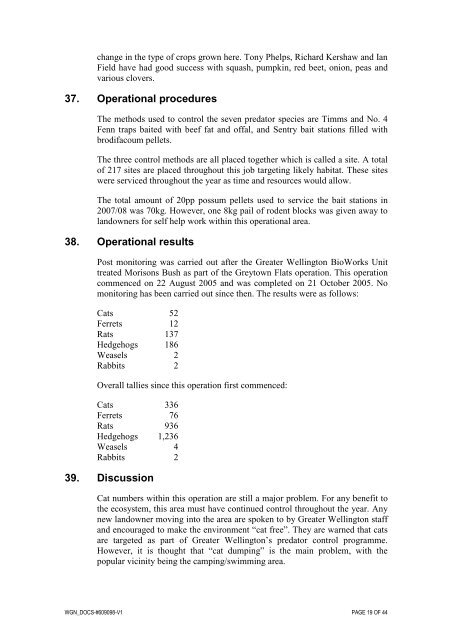Wairarapa Key Native Ecosystem Management Areas - Greater ...
Wairarapa Key Native Ecosystem Management Areas - Greater ...
Wairarapa Key Native Ecosystem Management Areas - Greater ...
You also want an ePaper? Increase the reach of your titles
YUMPU automatically turns print PDFs into web optimized ePapers that Google loves.
change in the type of crops grown here. Tony Phelps, Richard Kershaw and Ian<br />
Field have had good success with squash, pumpkin, red beet, onion, peas and<br />
various clovers.<br />
37. Operational procedures<br />
The methods used to control the seven predator species are Timms and No. 4<br />
Fenn traps baited with beef fat and offal, and Sentry bait stations filled with<br />
brodifacoum pellets.<br />
The three control methods are all placed together which is called a site. A total<br />
of 217 sites are placed throughout this job targeting likely habitat. These sites<br />
were serviced throughout the year as time and resources would allow.<br />
The total amount of 20pp possum pellets used to service the bait stations in<br />
2007/08 was 70kg. However, one 8kg pail of rodent blocks was given away to<br />
landowners for self help work within this operational area.<br />
38. Operational results<br />
Post monitoring was carried out after the <strong>Greater</strong> Wellington BioWorks Unit<br />
treated Morisons Bush as part of the Greytown Flats operation. This operation<br />
commenced on 22 August 2005 and was completed on 21 October 2005. No<br />
monitoring has been carried out since then. The results were as follows:<br />
Cats 52<br />
Ferrets 12<br />
Rats 137<br />
Hedgehogs 186<br />
Weasels 2<br />
Rabbits 2<br />
Overall tallies since this operation first commenced:<br />
Cats 336<br />
Ferrets 76<br />
Rats 936<br />
Hedgehogs 1,236<br />
Weasels 4<br />
Rabbits 2<br />
39. Discussion<br />
Cat numbers within this operation are still a major problem. For any benefit to<br />
the ecosystem, this area must have continued control throughout the year. Any<br />
new landowner moving into the area are spoken to by <strong>Greater</strong> Wellington staff<br />
and encouraged to make the environment “cat free”. They are warned that cats<br />
are targeted as part of <strong>Greater</strong> Wellington’s predator control programme.<br />
However, it is thought that “cat dumping” is the main problem, with the<br />
popular vicinity being the camping/swimming area.<br />
WGN_DOCS-#609098-V1 PAGE 19 OF 44
















